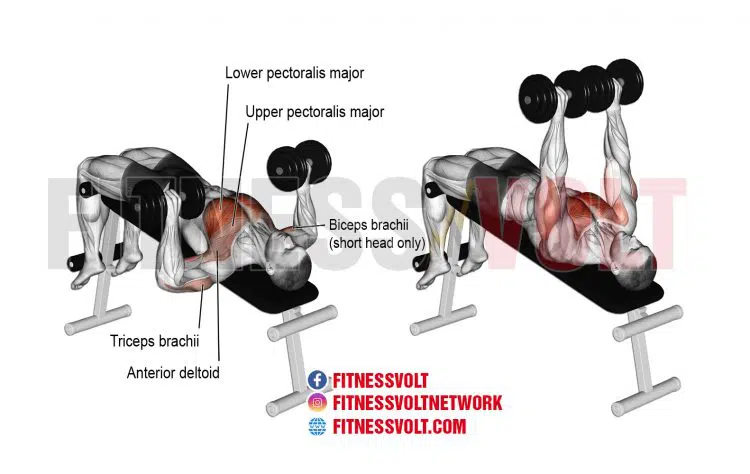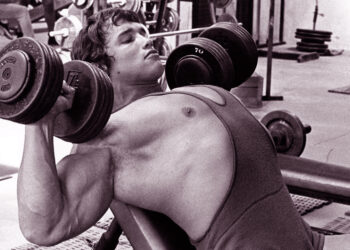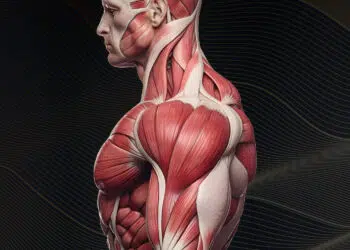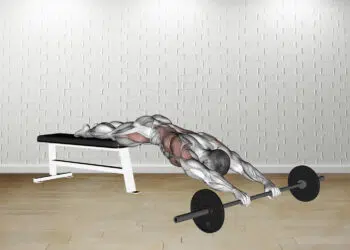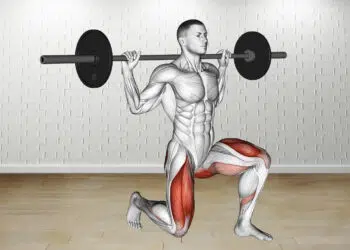If you are a fan of the classical chest/biceps split, implementing decline dumbbell bench presses is a must.
And why is that?
According to the study titled “Effect of Five Bench Inclinations on the Electromyographic Activity of the Pectoralis Major, Anterior Deltoid, and Triceps Brachii during the Bench Press Exercise,” decline bench press variation activates biceps brachii less than the flat bench press. (1)
Why is this important?
Based on my experience, many of you prefer to do supersets when doing the chest/biceps split. This means you will be able to perform your biceps exercises with more energy and less fatigue, resulting in better muscle hypertrophy effects.
As a Faculty of Sport and Physical Education student, I took over 20 hours to prepare an easy-to-follow guide on how to perform decline dumbbell bench presses properly without injuring yourself while also maximizing your lifting performance.
Level Up Your Fitness: Join our 💪 strong community in Fitness Volt Newsletter. Get daily inspiration, expert-backed workouts, nutrition tips, the latest in strength sports, and the support you need to reach your goals. Subscribe for free!
A Step-By-Step Guide for the Perfect Decline Dumbbell Bench Press Form
Below, I wrote an easy-to-follow guide on how to execute the decline dumbbell bench press perfectly.
Step One — Assume the Starting Lying Position
Set up the bench in the decline position with an angle between 15 and 30 degrees. Lie on the bench with the dumbbells and secure your legs below the leg attachment, or keep them hanging if you wish to activate your core musculature more. You should position your dumbbell weights right above your chest area with your elbows extended.
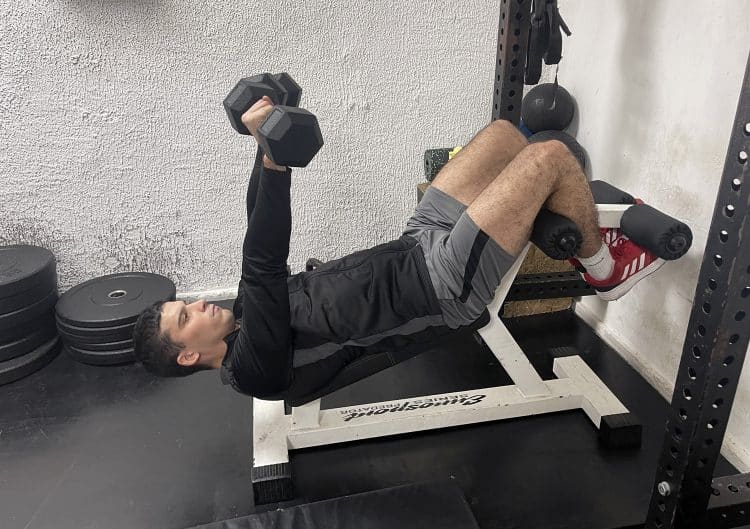
Pro Tip: Contract your glutes and abdominal muscles to ensure better stability during the exercise so you prevent potential injuries.
Step Two — Lower the Dumbbells Towards Your Chest (Eccentric Phase)
Start the exercise by lowering the dumbbells towards your chest area. This is done by horizontally abducting your shoulders and flexing your elbows. When the dumbbell is just above the level of your chest, hold that position for one second before transitioning to the last step.
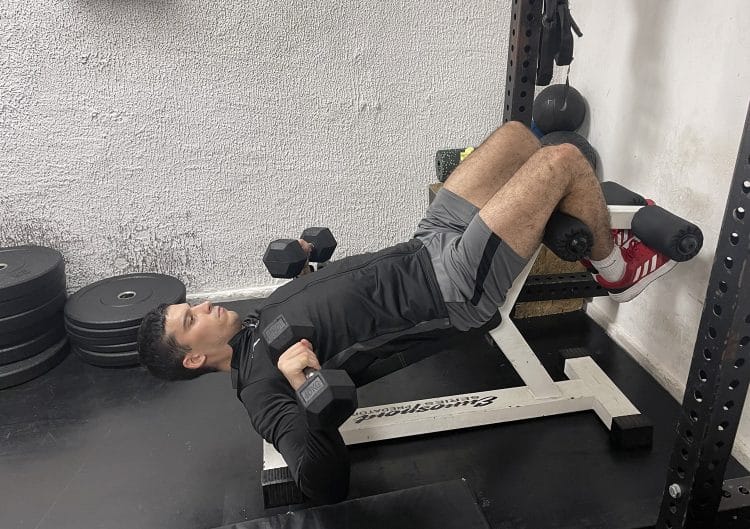
Pro Tip: If you have shoulder pain, rotate the dumbbells to enter the 45-degree angle, which is basically close to a neutral shoulder position.
Step Three — Push the Dumbbells Toward the Ceiling (Concentric Phase)
Now, I want you to push the dumbbells toward the ceiling by extending your elbows and horizontally adducting your shoulders. Do this as fast as possible to activate as many fast twitch fibers as possible. When the dumbbells are extended right above the level of your chest, the first rep is finished.
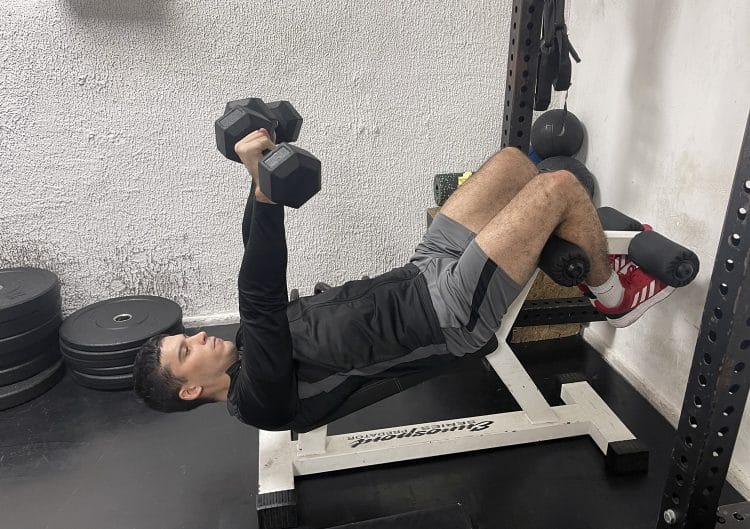
Pro Tip: If you want to build more muscle hypertrophy during the concentric phase, I advise prolonging it by changing the tempo to two seconds. This isn’t the best option for athletes who need explosive power. Still, bodybuilders utilize it quite often to increase their time under tension, which is also a factor for muscle hypertrophy.
Muscles Targeted by Dumbbell Decline Bench Presses
Based on my previous biomechanical analysis of the decline dumbbell bench press movement, here are the primary muscles working:
- Pectoralis major
- Triceps brachii
Also, here are the secondary muscles working:
- Anterior deltoid
- Serratus anterior
- Rotator cuff muscles
What Are the Benefits of a Decline Dumbbell Bench Press?
The benefits of a decline dumbbell bench press include emphasizing lower pectorals, reducing the stress on your shoulders, increasing your range of motion, stabilization and core engagement, and functional strength build-up.
Let’s tackle each of these briefly.
Emphasis on Lower Pectorals
Because of the unique angle during the decline of dumbbell bench press variation, you will hit more of the muscle fibers located on the bottom of your pectoral muscle. This is highly important because you will likely target these lower muscle fibers less than you need during the flat or incline bench press variation.
Reduced Stress on Shoulders
Again, the exercise angle is crucial here for lowering the stress on your shoulders.
This means your chest and triceps muscles will work more to perform the entire movement while only allowing the anterior deltoid to be a synergist. If you experience shoulder pain but still want to perform bench press variations, then choosing the decline is the safest option of all three.
Increased Range of Motion
The first two obvious reasons why we experience an increased range of options are the angle of the decline and the equipment (dumbbells) we choose. Now, there is one more reason regarding our scapula.
The decline position allows us to enter less shoulder blade protraction compared to the incline or flat bench press variations. This results in a longer motion path for our dumbbells since the chest is slightly more forward.
Stabilization and Core Engagement
All dumbbell exercise variations are excellent for teaching your body how to become more stable by activating your primary stabilizer muscles. In almost all scenarios, these muscles are the one of the core, including your glutes, erector spinae, transversus abdominis, rectus abdominis, obliquus internus, and obliquus externus.
Teaching your body to remain stable during the movement is crucial for preventing potential injuries during exercise.
Building Functional Strength
In terms of building functional strength, it is always better to go with free weights instead of machines. (2) However, among free weights, some are more functional than others. For example, dumbbells are more functional than barbells, but not compared to kettlebells.
The more the equipment imitates your daily movement patterns and requires your body to be more stable, the more functional it is.
Level Up Your Fitness: Join our 💪 strong community in Fitness Volt Newsletter. Get daily inspiration, expert-backed workouts, nutrition tips, the latest in strength sports, and the support you need to reach your goals. Subscribe for free!
This is why athletes mostly use free weights, with the exception of injury, where machines are more desirable.
What Are the Best Decline Dumbbell Bench Press Variations and Alternatives?
Below, I chose to include only the best decline dumbbell bench press variations and alternatives you should consider implementing in your workout routine.
Decline Dumbbell Flyes
Decline dumbbell flyes are excellent for building your lower chest. It is true that you can’t load them as much as the decline bench press variation, but they are a great exercise to implement towards the end of your workout or inside the chest compound set.
Usually, they are performed with the rep range between 6-12, and the percentage of 1RM (1 repetition maximum) is between 60 and 70%.
Steps:
- Set the decline bench with an angle between 15 and 30 degrees.
- Pick two dumbbells of appropriate weight and lie on your back on the decline bench.
- Put the dumbbell above your chest so both ends are touching. This means your shoulders are in the neutral starting position.
- Start the exercise by horizontally abducting your shoulders while keeping your elbows slightly flexed and fixed in that position during the entire movement.
- When your elbows reach or are just about to break the horizontal position, hold that position for a moment.
- Reverse the motion by returning the dumbbells to the starting position.
- Repeat for the desired amount of reps.
Pro Tip: Squeeze your shoulder blades and contract your core and glute muscles in the bottom position to achieve better stability and avoid injuries.
Decline Dumbbell Press With Neutral Grip
A decline dumbbell press with a neutral grip is an excellent decline bench press variation if you are experiencing shoulder pain or are coming back from a tough shoulder injury. A neutral position negates any of the problems you encounter during internal or external shoulder rotation.
Steps:
- Set the decline bench with an angle between 15 and 30 degrees.
- Pick two dumbbells of appropriate weight and lie on your back on the decline bench.
- Extend both dumbbells above the level of your chest and keep your elbows fully locked.
- Now rotate the dumbbells so your palms face in, and the dumbbells are in the neutral position.
- Start the exercise by lowering the dumbbell towards your chest by extending your shoulder and flexing your elbows.
- When both dumbbells reach the level of your chest, hold that position for one second.
- Reverse the motion to return to the starting position by extending your elbows.
Pro Tip: Actively squeeze your chest during the exercise to activate more muscle fibers and achieve better hypertrophy and strength effects.
Single-Arm Decline Dumbbell Press
The single-arm decline dumbbell bench press is an excellent unilateral variation for athletes. Also, anybody who strives to activate their core musculature more and teach their body to stabilize properly will benefit greatly from this exercise.
Steps:
- Set up the bench in the decline position with an angle between 15 and 30 degrees.
- Lie on the bench with the dumbbells and secure your legs below the leg attachment, or keep them hanging if you wish to activate your core musculature more.
- You should position a single in your right hand just above your chest area with your right elbow extended.
- Start the exercise by lowering the dumbbell towards your chest area.
- When the dumbbell is just above the level of your chest, hold that position for one second.
- Push the dumbbell toward the ceiling by extending your elbow and horizontally adducting your shoulder.
- Do this as fast as you can to activate as many of your fast twitch fibers as possible.
- When the dumbbells are extended right above the level of your chest, the first rep is finished.
Pro Tip: Actively contract your core and glute muscles to get better stability and prevent excessive movement in the frontal and transverse planes of motion.
Decline Dumbbell Pullover
Decline dumbbell pullovers are excellent finishers to include during the compound chest sets. I usually program it towards the end of my workouts.
Steps:
- Pick a dumbbell of appropriate weight and lie on the decline bench at 15-30 degrees.
- Extend the dumbbell above your chest and hold the further end of it with both your hands.
- Start the exercise by bringing the dumbbell behind your head and down slowly.
- I want you to keep your elbows flexed but in a fixed position during the entire movement. Only your shoulders should move.
- When you reach the end range of motion, hold that position for one second.
- Reverse the motion by bringing the dumbbell to the starting position above your chest.
- Repeat for the desired amount of reps.
Pro Tip: Don’t overarch your lumbar spine since that often leads to injury. To prevent overarching, simply contract your abdominal muscles to keep your lower back in place close to the bench.
Decline Barbell Bench Press
The decline barbell bench press is an excellent alternative that will allow you to use more weights because the barbell requires less stability than the dumbbells.
Steps:
- Set up the bench in the decline position with an angle between 15 and 30 degrees.
- Lie on the bench and secure your legs under the leg attachment.
- Load the barbell with the appropriate weight.
- Unrack the barbell and place it right above your chest.
- Start the exercise by lowering the loaded barbell towards your chest.
- When you reach the bottom position, just above your chest, hold it for one second.
- Reverse the motion by extending your elbows to return to the starting position.
- Repeat for the desired amount of reps.
Pro Tip: Slowly lower the barbell toward your chest with the utmost control. This will enable you to have more time under tension and induce better muscle hypertrophy effects.
FAQ’s
Is the decline dumbbell bench press effective?
The decline bench press is particularly effective at targeting your lower pectoral fibers. You can use it as an alternative, superset, or compound set exercise to build a well-rounded chest.
Which is better: incline or decline bench press?
It depends on your goals. If you aim to build an upper chest, performing incline bench press variation is better. On the contrary, if you aim to build lower chest fibers, then performing a decline bench press is a more viable choice.
Should I do all three bench press variations?
Yes, you should probably do all three bench press variations. This is the most effective and efficient way to build your chest muscles and develop all muscle fibers.
Can you do dumbbell bench presses every day?
You can theoretically do bench press every day. However, that likely won’t be as effective since your body needs to recover and enter glycogen supercompensation so you can build more muscle and lift more external resistance every following workout.
Wrapping Up
A Dumbbell decline bench press is an excellent variation for developing your lower chest area. You can include this exercise as a standalone in your workouts or in supersets for better hypertrophy effects.
To avoid injuries, you should pick appropriate dumbbells, preferably not more than 80% of your barbell bench press 1RM. In the comments below, let me know how you implement dumbbell decline bench press variation in your current workout regime.
References:
- Rodríguez-Ridao D, Antequera-Vique JA, Martín-Fuentes I, Muyor JM. Effect of Five Bench Inclinations on the Electromyographic Activity of the Pectoralis Major, Anterior Deltoid, and Triceps Brachii during the Bench Press Exercise. Int J Environ Res Public Health. 2020;17(19):7339. Published 2020 Oct 8. doi:10.3390/ijerph17197339
- Schwanbeck SR, Cornish SM, Barss T, Chilibeck PD. Effects of Training With Free Weights Versus Machines on Muscle Mass, Strength, Free Testosterone, and Free Cortisol Levels. J Strength Cond Res. 2020;34(7):1851-1859. doi:10.1519/JSC.0000000000003349
Relevant Articles:
- How to do the decline hammer-grip dumbbell bench press
- How to Incline Dumbbell Press
- Lee Priest Compares Decline Bench Press vs Flat Bench
- Flat Vs.Incline Vs. Decline Bench Press
Interested in measuring your progress? Check out our strength standards for Bench Press, Dumbbell Pullover, Decline Bench Press, and more.

